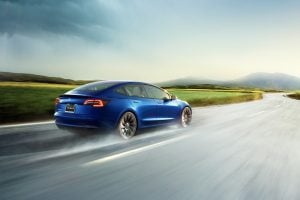Is a way forward for driverless vehicles upon us? Not precisely – it’s basically extra superior driver help.
Legally, Tesla drivers utilizing this mode should be able to take management and concentrate always. Calling it “full self-driving” is questionable.
The transfer comes amid scrutiny. This week, a video confirmed a Tesla navigating roads in Melbourne’s CBD with out the motive force’s fingers on the wheel.
Authorities warned these trials had not been authorised.
It’s a reminder of how contested “self-driving” stays. Whereas the expertise is advancing quickly, there are nonetheless actual considerations over laws, technological readiness, security and public belief.
Is it authorized?
Tesla’s FSD mode shouldn’t be really driverless. Technically, it’s labeled as a complicated driver help system. On the recognised five-level record of more and more automated vehicles, the place 5 is totally automated, FSD is a Degree 2.
At this stage, the motive force has to stay attentive and able to take correct management. Legally, this implies Tesla’s FSD could be handled the identical manner as different automobiles with superior driver-assist programs. Tesla vehicles with FSD working could be compliant with Australian laws and authorized to make use of with human oversight.
A Tesla retailer. Picture: AdobeStock
At larger ranges of automation (Ranges 3-5), the automobile takes on the entire driving process with out fixed supervision, which might be thought-about “automated driving”. Degree 3 vehicles exist in restricted markets abroad. Degree 4 vehicles are being utilized in fleet-based robotaxi trials however not bought to customers. Degree 5 vehicles providing true autonomy, anyplace, anytime don’t but exist.
At current, vehicles with Degree 3 automation and above should not compliant with Australian laws and may’t function with out particular permits for trials and testing. They’ve strict situations on security, insurance coverage, knowledge sharing and geographic restrictions.
For this reason the Tesla video in Melbourne video triggered pushback – it gave the look of the next stage of automation than legally permitted and not using a trial allow.
What can FSD really do?
Tesla is taking a phased strategy to allow FSD for eligible automobiles in Australia.
On this mode, the automobile can change lanes, navigate interchanges, recognise cease indicators and robotically convey the automobile to a cease. It may well even deal with Melbourne’s well-known hook turns.
However the system has laborious limits. The motive force should be able to step in at any second. The system could make errors in complicated or unpredictable settings.
Abroad, Tesla is selling a brand new supervised characteristic – autosteer on metropolis streets – which might transcend automated freeway driving into extra complicated residential and metropolis roads with roundabouts, visitors lights and pedestrians. However this characteristic stays “upcoming” in Australia.
Tesla’s strategy to self-driving stays controversial. To sense their environment, the automobiles rely primarily on cameras and synthetic intelligence. Critics argue this leaves the system extra susceptible to errors. Different self-driving automobile builders comparable to Waymo have added LiDAR and radar sensors to spice up security in case different sensors fail.
Tesla’s branding of FSD as a step in the direction of full autonomy is deceptive. In actuality, it’s nearer to a diligent learner driver than an expert chauffeur. It may well learn the highway, however nonetheless wants shut supervision.
The lengthy highway to autonomy
Tesla’s push into autonomy is partly about capturing market share within the fast-emerging robotaxi business.
Tesla CEO Elon Musk has promised Tesla vehicles will sooner or later have the ability to be monetised in a shared robotaxi fleet.
In June, the primary Tesla Robotaxi went dwell in restricted areas of Austin, Texas. However these automobiles should not really driverless – a human security monitor should be on board.
Globally, Tesla is one in every of many corporations vying for a share of the robotaxi market. Trials are increasing rapidly. Waymo is main the race with paid driverless rides in a number of cities in america. Its Jaguar vehicles are Degree 4 autonomous, capable of drive unsupervised however solely in a set space.
In the meantime, Baidu, WeRide and Pony.ai are scaling up in China, their home market, in addition to the Gulf area, together with Dubai, Abu Dhabi and Riyadh.
True self-driving vehicles are a manner off
What if a self-driving client automobile causes a crash? For a Degree 2 automobile, supervising human drivers stay accountable.
But when a real self-driving automobile triggered a crash, legal responsibility may fall on the producer and even the software program developer. Regulators are working to resolve this authorized gray space.

The Tesla Mannequin 3
At the same time as Tesla pushes in the direction of self-driving, the corporate faces a category motion from hundreds of Australian drivers over alleged “phantom braking” the place the vehicles abruptly brake for no obvious motive, risking rear-end crashes.
Tesla says its system could be affected by obstructed cameras and drivers are at all times chargeable for sustaining management.
This echoes a wider debate: how protected should autonomous programs be earlier than they will substitute human drivers? Human error is a serious reason behind highway crashes. However glitches comparable to phantom braking undermine confidence and public belief, particularly when lives are at stake.
Within the US, federal authorities are investigating crashes linked to Tesla’s driver-assist programs. California’s regulator has accused Tesla of deceptive promoting, and senators have pressed for more durable oversight of Tesla’s advertising and marketing.
Regardless of progress, basic breakthroughs are nonetheless required to deal with uncommon however high-risk situations, comparable to pedestrians behaving unexpectedly.
The highway forward
Automobiles with superior driver-assist can recognise objects and comply with guidelines. However surprising issues can occur.
True autonomy calls for the power to interpret complicated and ambiguous human behaviour.
Till then, the motive force should stay firmly in cost.![]()
Hussein Dia, Professor of Transport Expertise and Sustainability, Swinburne College of Expertise
This text is republished from The Dialog below a Artistic Commons license. Learn the unique article.



